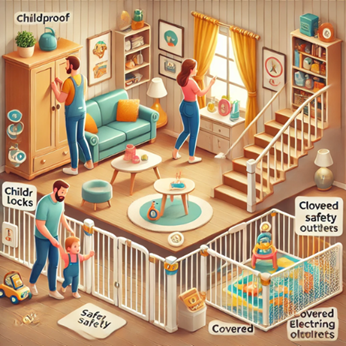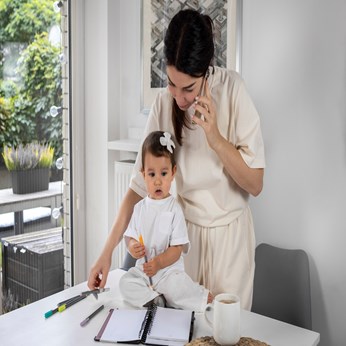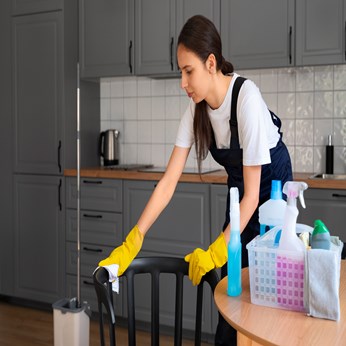Preventing Common Household Accidents: A Parent’s Checklist

As parents, our top priority is keeping our little ones safe. While we can’t predict every accident, we can certainly take steps to prevent many of them. Household accidents are more common than we’d like to think, but with a little awareness and preparation, we can create a safer environment for our children. Here’s a friendly checklist to help you prevent common household accidents!
1. Secure Heavy Furniture
Kids are naturally curious and love to climb. To prevent tipping accidents, secure heavy furniture like bookshelves, dressers, and TVs to the wall. Use anti-tip straps or brackets to keep them stable. This simple step can make a world of difference!
2. Keep Hazardous Materials Out of Reach
Cleaning supplies, medications, and other hazardous materials should always be stored out of reach or in locked cabinets. Consider using childproof locks on cabinets to ensure that little hands can’t access dangerous items. Remember, a little prevention goes a long way!
3. Install Safety Gates
If you have stairs in your home, installing safety gates at the top and bottom is a must. This will help prevent falls and keep your little ones safe as they explore. Make sure the gates are sturdy and properly installed for maximum safety.
4. Use Non-Slip Mats
Slips and falls can happen anywhere, especially in the bathroom or kitchen. Use non-slip mats in these areas to provide extra traction. Additionally, make sure to clean up spills immediately to prevent accidents.
5. Cover Electrical Outlets
Curious toddlers love to explore, and electrical outlets can be a tempting target. Use outlet covers to prevent little fingers from poking around. It’s a quick and easy way to add an extra layer of safety to your home.
6. Keep Choking Hazards Away
Small objects like coins, buttons, and toys can pose choking hazards for young children. Regularly check your living spaces for items that could be dangerous and keep them out of reach. Encourage older siblings to keep their toys organized and away from younger ones.
7. Practice Fire Safety
Make sure your home is equipped with smoke detectors and carbon monoxide detectors. Test them regularly to ensure they’re working properly. Create a fire escape plan with your family and practice it so everyone knows what to do in case of an emergency.
8. Supervise Water Activities
Whether it’s a bath, a pool, or a bucket of water, always supervise your children around water. Drowning can happen quickly and silently, so never leave kids unattended, even for a moment. Teach them about water safety as they grow older.
9. Educate About Kitchen Safety
The kitchen can be a dangerous place for little ones. Teach your children about kitchen safety, such as staying away from hot surfaces and sharp objects. Use stove knob covers to prevent accidental burns and keep knives out of reach.
10. Create a Safe Play Area
Designate a safe play area in your home where your children can play freely. Remove any sharp objects, breakable items, or potential hazards from this space. Soft rugs and cushions can help create a comfortable and safe environment for playtime.
Beware and stay alert
By taking proactive steps to prevent common household accidents, you can create a safer environment for your children to explore and grow. Remember, safety is an ongoing process, so regularly review your home for potential hazards and make adjustments as needed.
With a little awareness and preparation, you can enjoy peace of mind knowing that you’re doing your best to keep your family safe. Here’s to happy, healthy, and accident-free living!
Take the next step toward your goals
Share your requirement and find the best care providers in your area
-
Looking for a caretaker’s job? Build your profile and get in touch with families in your vicinity.
-
Discover nannies, babysitters, cooks, housekeepers, pet sitters, and elder care under one roof.
-
Get all the support you need to run a successful care center.
-
Search for appropriate centers near you depending on your needs.
Care Corner Insights: Blog Library

Overnight Babysitters in Bellevue, WA for Business-Travelling NRI Parents: Safety & Policies
For many NRI parents living in Bellevue, WA, frequent business trips are a reality. While traveling, one of the biggest concerns is ensuring your children are safe, cared for, and emotionally supported during overnight stays. Overnight babysitters ca

Indian Home-Style Cooks in Queens, NY: Tiffin-Style Weekly Meal Prep from Your Kitchen
Queens, NY, is home to one of the most diverse food cultures in the country, and Indian cuisine holds a special place among families looking for authentic, comforting meals. While restaurant takeout is convenient, nothing compares to the taste and nu

Baby Sleep Problems: What is Sleep Regression and How to Handle It
If you’re a parent, you know that baby sleep is one of the greatest mysteries of life. One day your little one is snoozing like an angel, and the next day they’re suddenly waking up every hour, fussing, or refusing to nap. Before you panic, there’s a

What is Validation Therapy? A New Approach to Dementia Care
Caring for loved ones with dementia is one of the most emotionally challenging journeys a family can face. Traditional methods often focus on correcting memory lapses or redirecting confused thoughts—but that can sometimes lead to frustration, stress

What is a Part-Time Nanny and Do You Need One
Parenting is a beautiful journey, but let’s be honest—it can also be exhausting! Between work deadlines, household chores, and family responsibilities, sometimes there just aren’t enough hours in a day. That’s where part-time nannies step in, offerin

Part-Time Housekeeper Hiring in Alpharetta, GA: Weekly Schedules, Pricing, and Must-Do Tasks
Keeping a home spotless while balancing work, family, and personal commitments can be overwhelming. For families and professionals in Alpharetta, GA, hiring a part-time housekeeper is one of the most practical solutions. Whether you need help once a

Affordable Daycares in Irving, TX with Indian Menu Options: Parent Reviews & Enrollment Tips
Finding the right daycare for your little one is never an easy decision—especially if you’re looking for one that fits your budget and offers familiar food options like an Indian-inspired menu. For parents in Irving, TX, the good news is that several

Can Babies Sleep on Their Side? Tips for Safe Baby Sleep
When it comes to newborns, every parent worries about the smallest details—how they sleep, what they wear, even which way they turn their tiny heads. One common question that pops up is: “Can babies sleep on their side?” The short answer? Not recom

8 Benefits of Hiring a House Cleaner for Your Home
Let’s be honest — keeping a home sparkling clean while juggling work, family, and daily life can feel like a full-time job in itself. That’s where professional house cleaners step in, turning the chaos into calm. If you’ve been debating whether to br

How to Care for a Gassy Baby? What’s Normal and what’s not – Expert Advice
If you’re a new parent navigating the world of burps, bubbles, and baby fussiness—welcome to the club! Gas in babies is incredibly common, especially in the first few months. But how do you know what’s normal and when it’s time to call in expert help